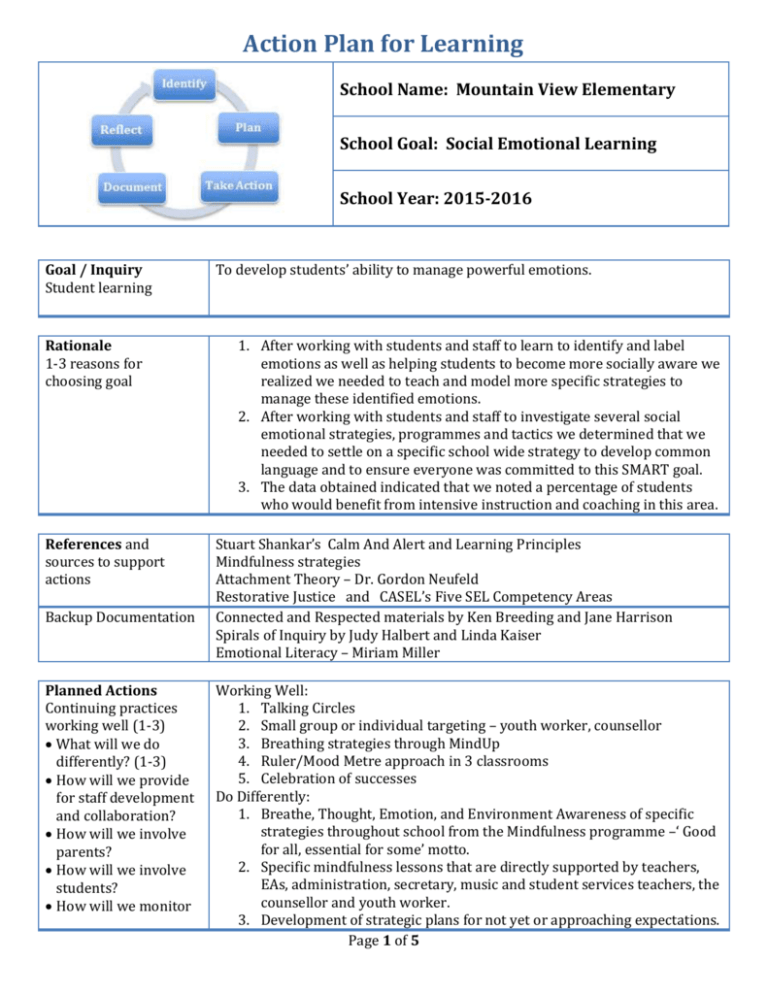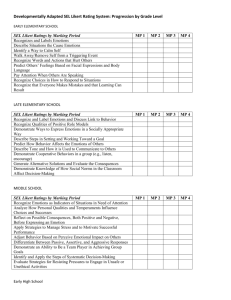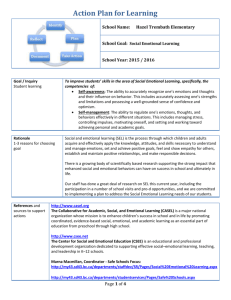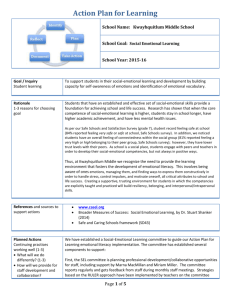document
advertisement

Action Plan for Learning School Name: Mountain View Elementary School Goal: Social Emotional Learning School Year: 2015-2016 Goal / Inquiry Student learning Rationale 1-3 reasons for choosing goal References and sources to support actions Backup Documentation Planned Actions Continuing practices working well (1-3) What will we do differently? (1-3) How will we provide for staff development and collaboration? How will we involve parents? How will we involve students? How will we monitor To develop students’ ability to manage powerful emotions. 1. After working with students and staff to learn to identify and label emotions as well as helping students to become more socially aware we realized we needed to teach and model more specific strategies to manage these identified emotions. 2. After working with students and staff to investigate several social emotional strategies, programmes and tactics we determined that we needed to settle on a specific school wide strategy to develop common language and to ensure everyone was committed to this SMART goal. 3. The data obtained indicated that we noted a percentage of students who would benefit from intensive instruction and coaching in this area. Stuart Shankar’s Calm And Alert and Learning Principles Mindfulness strategies Attachment Theory – Dr. Gordon Neufeld Restorative Justice and CASEL’s Five SEL Competency Areas Connected and Respected materials by Ken Breeding and Jane Harrison Spirals of Inquiry by Judy Halbert and Linda Kaiser Emotional Literacy – Miriam Miller Working Well: 1. Talking Circles 2. Small group or individual targeting – youth worker, counsellor 3. Breathing strategies through MindUp 4. Ruler/Mood Metre approach in 3 classrooms 5. Celebration of successes Do Differently: 1. Breathe, Thought, Emotion, and Environment Awareness of specific strategies throughout school from the Mindfulness programme –‘ Good for all, essential for some’ motto. 2. Specific mindfulness lessons that are directly supported by teachers, EAs, administration, secretary, music and student services teachers, the counsellor and youth worker. 3. Development of strategic plans for not yet or approaching expectations. Page 1 of 5 progress and adjust actions? 4. Class reviews in September to include this goal and strategic plans. Staff Development: School based Pro-D, staff meetings and during weekly collaboration times Targeted funding to support staff to attend Pro-D throughout year Direct behavior team and CAST involvement and support Students: Student Voice and St. Leadership to take on roles to support others Teacher and Student Self-assessment in Oct., March and May Clear intentions, direct feedback and ongoing coaching to achieve goals Involvement of parents in parenting classes, classroom and IBP goals Behavior team involvement and support Demonstration and ownership of their own learning activities Monitor Progress: Use of rubric in Oct, March and May Creation of IBPs as needed and ongoing team meetings to monitor process of class, groups and individuals closely Identification of specific age group expectations and indicators Frequent celebration and recognition of successes along the way Backup Documentation APL 2015-2016 Social Responsiblity Planning Draft.doc Interim reports, team meeting notes, functional assessments, levels plans, IBPs, rubrics, Early Learning Self-Regulation Continuum Page 2 of 5 Documentation of learning Key evidence of change How did your actions make a difference? Choose 1-3 pieces of evidence to demonstrate the impact your actions have had on student learning to meet your goal. Documentation could include video, survey results, performance standard data, anecdotal evidence, work samples, etc. During the 2014-2015 school year our exploration of various SEL strategies and tactics included: Ruler approach, Mood Metres, Self-regulation, attachment theories, Mind Up, Talking Circles, Anxiety, emotional intelligence, NED, positive behavior support and CASEL. See list on attached SEL Inquiry and Actions document below. While we targeted identifying emotions, teachers worked individually and together to deepen their understanding and to enhance their overall SEL practices. Support from the behavior team, our counsellor and youth workers, CAST and outside medical professionals has helped us collectively to move forward in this area. Evidence: More students are independently and successfully using breathing, brain breaks, headphones, wiggle cushions, etc. Anecdotally teachers are reporting that there is a growth in specific individuals, in student groups and classrooms in their ability to identify emotions when direct instruction and coaching occurs. We realized that we needed to do more work on powerful emotions and documenting the results of our efforts. We were able to increase our counselling time for next year to .6 in order to maximize our efforts for those students approaching expectations or not yet meeting in these two areas. Backup Documentation SEL Inquiry and Interim Report Card Managing Powerful Actions of Teachers for 2014-2015.docx Data.doc Emotions.docx Reflection Highlights Where are we now? What are some patterns emerging? What surprised you? What conclusions / inferences might you draw? How does this inform potential next steps? Backup Documentation Staff wishes to pursue a school wide approach and this is an area where there has been great interest and ongoing research. The increase in childhood anxiety related concerns along with the challenge of changing cultural norms has not escaped our small school. Certain clusters of age peers made it more challenging to create a wellfunctioning classroom due to their difficulties in this area. We were surprised that despite extensive collaboration, preplanning and training we were unable to anticipate the social emotional difficulties some of our students experienced over the year. We recognized that we needed to train all students not only the identification of powerful emotions but direct instruction in how to manage them more effectively. We also needed to include our parents even more in this educational process. We concluded that focusing on a SMART measureable goal that everyone embraced was the best next step. We also know that creating a classroom of acceptance and caring is the always first step in this process along with maximization of active engagement learning principles. Heart and Mind Index – www. dalailamacenter.org/programs/heart-mindindex (Delete this section if Literacy is your main goal) Page 3 of 5 Literacy Data Attach the following : Classroom Assessment School Assessment FSA results Mountain View - CBA for APL 2015.doc FSA results not yet available Page 4 of 5 Signatures School Name: Mountain View Elementary School Goal: Social Responsibility School Year: 20152016 Submitted by School Planning Council: Title Name Principal Marsha Arnold Parent Tanya Austin Parent Cynthia Marston Parent Recommended by Assistant Superintendent: Assistant Superintendent Carey Chute Board and Superintendent Approval: Board Chair Judy Shirra Superintendent Patricia Gartland Print this page, have it signed by School Planning Council, scan it and attach it here Adobe Acrobat Document Page 5 of 5 Signature











